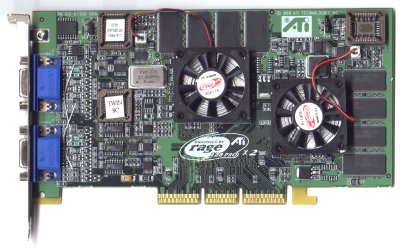Preview of the Double Whopper - ATI's Rage Fury MAXX
Introduction
In early October we brought you a small preview of the Rage Fury MAXX to give you an idea of what ATI has coming in the very near future. This future will soon become reality as we have been proven that things are moving along fairly well for the Fury MAXX. ATI once again dropped by the US lab for a few hours to let us crash-test the current status of their Rage 128 Pro AFR (Fury MAXX), which is very close to being released. The drivers have been improved as well as the board itself. This is still not a final release of the product but it should give us a good idea of what the product should and shouldn't be able to do.
Rage Fury MAXX
For those of you who don't recall what the Fury MAXX is, it's basically two Rage Pro's on a single board using AFR technology . This gives them a "brute force" method at getting higher fill-rate and memory bandwidth. Thanks to the two separate core's (running at 125 MHz each) working in conjunction, we get nice fill-rate performance (500 MPixels/s) as well as broad memory bandwidth with each core having a dedicated frame buffer (two independant 32 MB sets of memory running at 143 MHz).
Before we get into the benchmark results, let have a quick look over the features of Fury MAXX in comparison with the other high-end 3D-solution, the GeForce from NVIDIA.
| Fill Rate | |
|---|---|
| ATI Rage128 Pro AFR | NVIDIA GeForce256 |
| 2 x 250 Mpixels/s = 500 Mpixels/s | 480 Mpixels/s |
In terms of fill rate, Fury MAXX has a slight edge over GeForce, but generally both solutions are close to identical. This will mean that both cards will score close to the same in games that don't use T&L, if fill rate is the only limiting factor.
| Memory Bandwidth | |
|---|---|
| ATI Rage128 Pro AFR | NVIDIA GeForce256 |
| 2 x 2.288 GB/s = 4.576 GB/s | 2.656 GB/s as SDR-version5.312 GB/s as DDR-version |
You can see that Fury MAXX is way ahead of GeForce w/SDR in terms of memory performance. This will make Fury MAXX look a lot better than GeForce's SDR-version at high resolutions and high color-depths. GeForce's DDR-version however comes with a higher memory-bandwidth than Fury MAXX, something that might cost a lot more money though.
Get Tom's Hardware's best news and in-depth reviews, straight to your inbox.
